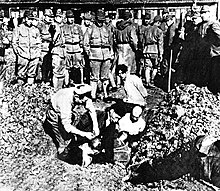Casualties and war crimes

Estimates for the total casualties of the war vary, because many deaths went unrecorded. Most suggest that some 60 million people died in the war, including about 20 million soldiers and 40 million civilians. Many civilians died because of disease, starvation, massacres, bombing and deliberate genocide. The Soviet Union lost around 27 million people during the war, almost half of all World War II deaths.One of every four Soviet citizens was killed or wounded in that war.
Of the total deaths in World War II approximately 85 percent—mostly Soviet and Chinese—were on the Allied side and 15 percent on the Axis side. Many of these deaths were caused by war crimes committed by German and Japanese forces in occupied territories. An estimated 11 to 17 million civilians died as a direct or indirect result of Nazi ideological policies, including the systematic genocide of around six million Jews during The Holocaust along with a further five million Roma, Slavs,homosexuals and other ethnic and minority groups. Roughly 7.5 million civilians died in China under Japanese occupation, and the Serbs were targeted by the Axis-aligned Croatian Ustaše.
The most well-known Japanese atrocity was the Nanking Massacre, in which several hundred thousand Chinese civilians were raped and murdered. Between 3 million to more than 10 million civilians, mostly Chinese, were killed by the Japanese occupation forces. Mitsuyoshi Himeta reported 2.7 million casualties occurred during theSankō Sakusen. General Yasuji Okamura implemented the policy in Heipei and Shantung.
The Axis forces employed limited biological and chemical weapons. The Italians used mustard gas during their conquest of Abyssinia, while the Imperial Japanese Army used a variety of such weapons during their invasion and occupation of China (see Unit 731) and in early conflicts against the Soviets. Both the Germans and Japanese tested such weapons against civilians and, in some cases, on prisoners of war.
While many of the Axis's acts were brought to trial in the world's first international tribunals, incidents caused by the Allies were not. Examples of such Allied actions include population transfer in the Soviet Union and Japanese American internment in the United States; the Operation Keelhaul, expulsion of Germans after World War II, mass rape of German women by Soviet Red Army; the Soviet Union's Katyn massacre, for which Germans faced counter-accusations of responsibility. Large numbers of famine deaths can also be partially attributed to the war, such as the Bengal famine of 1943 and the Vietnamese famine of 1944–45.
It has also been suggested by some historians the mass-bombing of civilian areas in enemy territory, including Tokyo and most notably the German cities of Dresden, Hamburg, and Cologne by Western Allies,which resulted in the destruction of more than 160 cities and killing a total of more than 600,000 German civilians be considered war crimes.

No comments:
Post a Comment